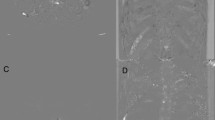Abstract
In order to aid radiologists’ routine work for interpreting bone scan images, we developed a computerized method for temporal subtraction (TS) images which can highlight interval changes between successive whole-body bone scans, and we performed a prospective clinical study for evaluating the clinical utility of the TS images. We developed a TS image server which includes an automated image-retrieval system, an automated image-conversion system, an automated TS image-producing system, a computer interface for displaying and evaluating TS images with five subjective scales, and an automated data-archiving system. In this study, the radiologist could revise his/her report after reviewing the TS images if the findings on the TS image were confirmed retrospectively on our clinical picture archiving and communication system. We had 256 consenting patients of whom 143 had two or more whole-body bone scans available for TS images. In total, we obtained TS images successfully in 292 (96.1%) pairs and failed to produce TS images in 12 pairs. Among the 292 TS studies used for diagnosis, TS images were considered as “extremely beneficial” or “somewhat beneficial” in 247 (84.6%) pairs, as “no utility” in 44 pairs, and as “somewhat detrimental” in only one pair. There was no TS image for any pairs that was considered “extremely detrimental.” In addition, the radiologists changed their initial reported impression in 18 pairs (6.2%). The benefit to the radiologist of using TS images in the routine interpretation of successive whole-body bone scans was significant, with negligible detrimental effects.







Similar content being viewed by others
References
UNSCEAR: Report to the general assembly, with scientific annexes. New York: United Nations Scientific Committee on the Effects of Atomic Radiation, 2000
Scanff P, Donadieu J, Pirard P, Aubert B: Population exposure to ionizing radiation from medical examinations in France. Br J Radiol 81:204–213, 2008
Tobis JM, Nalcioglu O, Henry WL: Digital subtraction angiography. Chest 84:68–75, 1983
Shiraishi J, Li Q, Appelbaum D, Pu Y, Doi K: Development of a computer-aided diagnostic scheme for detection of interval changes in successive whole-body bone scans. Med Phys 34:25–36, 2007
Shiraishi J, Appelbaum D, Pu Y, Li Q, Pesce L, Doi K: Usefulness of temporal subtraction images for identification of interval changes in successive whole-body bone scans: JAFROC analysis of radiologists’ performance. Acad Radiol 14:959–966, 2007
Li Q, Katsuragawa S, Doi K: Improved contralateral subtraction images by use of elastic matching technique. Med Phys 27:1934–1942, 2000
Acknowledgments
We are grateful to Hiroyuki Abe, MD, for his useful suggestions and to Elisabeth Lanzl for improving the manuscript. K. Doi is a shareholder in Hologic/R2 Technology, Inc., Los Altos, CA. CAD technologies developed in the Kurt Rossmann Laboratories have been licensed to R2 Technology, Deus Technologies, Riverain Medical Group, Mitsubishi Space Software Co., Median Technologies, General Electric Corporation, and Toshiba Corporation. It is the policy of The University of Chicago that investigators disclose publicly actual or potential significant financial interests that may appear to affect research activities or that may benefit from research activities.
Author information
Authors and Affiliations
Corresponding author
Rights and permissions
About this article
Cite this article
Shiraishi, J., Appelbaum, D., Pu, Y. et al. Clinical Utility of Temporal Subtraction Images in Successive Whole-Body Bone Scans: Evaluation in a Prospective Clinical Study. J Digit Imaging 24, 680–687 (2011). https://doi.org/10.1007/s10278-010-9322-5
Published:
Issue Date:
DOI: https://doi.org/10.1007/s10278-010-9322-5




